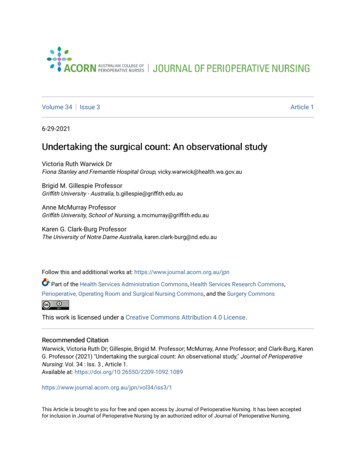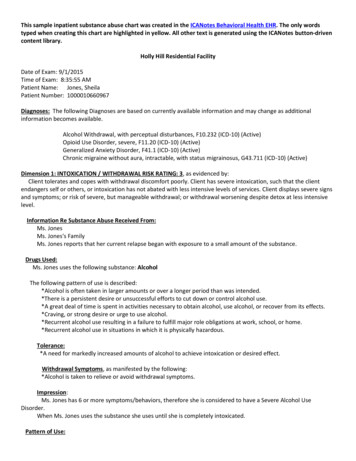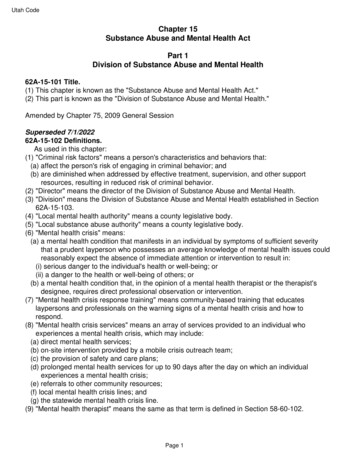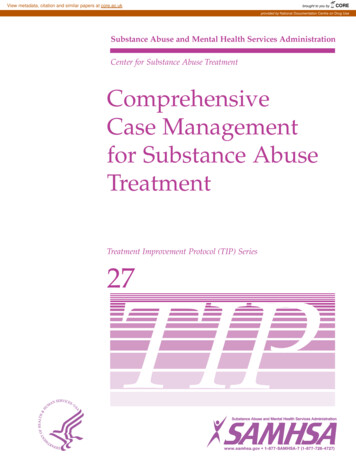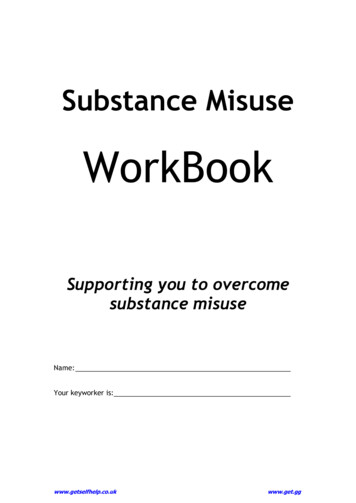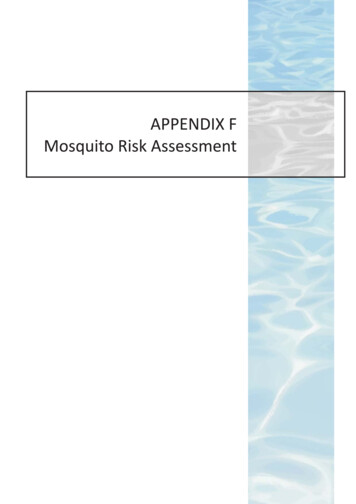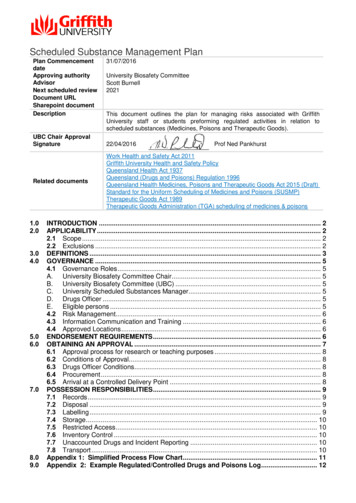
Transcription
Scheduled Substance Management PlanPlan CommencementdateApproving authorityAdvisorNext scheduled reviewDocument URLSharepoint documentDescriptionUBC Chair ApprovalSignatureRelated ersity Biosafety CommitteeScott Burnell2021This document outlines the plan for managing risks associated with GriffithUniversity staff or students preforming regulated activities in relation toscheduled substances (Medicines, Poisons and Therapeutic Goods).22/04/2016Prof Ned PankhurstWork Health and Safety Act 2011Griffith University Health and Safety PolicyQueensland Health Act 1937Queensland (Drugs and Poisons) Regulation 1996Queensland Health Medicines, Poisons and Therapeutic Goods Act 2015 (Draft)Standard for the Uniform Scheduling of Medicines and Poisons (SUSMP)Therapeutic Goods Act 1989Therapeutic Goods Administration (TGA) scheduling of medicines & poisonsINTRODUCTION . 2APPLICABILITY . 22.1 Scope . 22.2 Exclusions . 2DEFINITIONS . 3GOVERNANCE . 54.1 Governance Roles . 5A. University Biosafety Committee Chair. 5B. University Biosafety Committee (UBC) . 5C. University Scheduled Substances Manager. 5D. Drugs Officer . 5E. Eligible persons . 54.2 Risk Management. 64.3 Information Communication and Training . 64.4 Approved Locations . 6ENDORSEMENT REQUIREMENTS . 6OBTAINING AN APPROVAL . 76.1 Approval process for research or teaching purposes . 86.2 Conditions of Approval. 86.3 Drugs Officer Conditions. 86.4 Procurement . 86.5 Arrival at a Controlled Delivery Point . 8POSSESSION RESPONSIBILITIES . 97.1 Records . 97.2 Disposal . 97.3 Labelling . 97.4 Storage. 107.5 Restricted Access . 107.6 Inventory Control . 107.7 Unaccounted Drugs and Incident Reporting . 107.8 Transport . 10Appendix 1: Simplified Process Flow Chart . 11Appendix 2: Example Regulated/Controlled Drugs and Poisons Log . 12
1.0INTRODUCTIONCurrently the use of Drugs and Poisons is regulated under the Health (Drugs and Poisons) Regulation 1996;under the Health Act 1937, however this will be replaced by the proposed Medicines, Poisons andTherapeutic Goods Act in 2017. The new Act will offer consistency with other States and NationalRegulation, to ensure proper access, proper use, the proper product and the proper person in relation tomedicines, poisons and therapeutic substances. Under the Act an entity undertaking activities involvingregulated substances must have a Scheduled Substance Management Plan (SSMP). The SSMP mustoutline the organisation’s processes for the procurement, storage, handling, record-keeping, stock keepingand disposal of medicines and poisons to ensure safety, security and quality.Specifically the SSMP must specify the University’s procedures for medicines and poisons to ensure: individuals have the necessary qualifications, expertise and authority to undertake a regulated activityinvolving scheduled substances. compliance with the plan is monitored, including reporting, investigation and follow-up of any adverseevents associated with the quality, safety and security of a substance. authorisation, authentication and non-repudiation of instruction to supply or administer a medicine orpoison. authorised purchase of a substance from a source external to the licensee, business or entity tominimise the risk of a substance being obtained for illicit purposes. restricted access to storage facilities, including measures to be taken to prevent unauthorised accessto a storage facility. control inventory and reconciliation processes to prevent, detect and/or deter unauthorised accessthat could result in a substance or relevant records being lost, stolen, misplaced or misused. substances are disposed of, or destroyed in order to prevent accumulation, unauthorised access orpublic harm. the safe and secure transport, holding and delivery of substances by managing the chain of custody inorder to prevent them from being lost, stolen, misplaced or misused.Note: The Schedule to which a medicine or poison is assigned can also be identified using ChemWatchGoldFFX .2.0APPLICABILITY2.1ScopeThe SSMP applies to medicine and poison transactions involving: research activities; learning and teaching activities; formal agreements between the University and external organisations when the Universityoccupies a building and is responsible for the management of the facility e.g. a remoteclinic; Any other activity directly controlled by Griffith University.2.2ExclusionsThis plan does not cover medicines, poisons and therapeutic substances in the followingcircumstances: used within the scope of responsibilities allocated to the University Health Services or GPclinics; under the control of individuals for personal needs, e.g. adrenaline to treat anaphylaxis; used and controlled by other commercial entities located on campus e.g. a Commercialpharmacy.Page 2 of 12
3.0DEFINITIONSAppropriately Qualified: for an Officer of the University, refers to someone having the qualifications,experience or standing appropriate to the exercise of the power. A person assigned the followingpositions would be nominated by the Head of Element and confirmed by the appropriate seniormanager such as Group PVC: Drugs Officer; Senior Research Academic; Technical Managers; University Scheduled Substance Manager; Manager – University Safety Team; and Health & Safety Adviser (Chemicals & Radiation), University Safety Team.Authority: Means the power to make decisions and/or enforce conditions a person has under theRegulation.Applicant: refers to the person applying for approval under section 18(1) of the Regulation. Thisperson is usually an academic or research staff member.Drugs Officer: a person authorised by a Group or Element to monitor the use and storage ofscheduled substances and the person who applies for an endorsementon behalf of an Applicant.Eligible Person: person required to perform regulated activities in the course of their occupation orengagement. Also includes persons registered or those undergoing training to become a registeredhealth professional or veterinary surgeon.Emerging Substance: a substance not previously listed under the SSMP which is declared as ascheduled substance by the government.Endorsement: an authority, approval, certification, drug licence or permit.Endorsement Holder: person whose name appears on an endorsement.Medicine: a Scheduled substance in the category of an S2, S3 or S4 medicine.Monitored Substance: an S8 Medicine or substance prescribed by Regulation to be a monitoredsubstance.Poison: a Scheduled substance in the category of an S5, S6 or S7 poison.Possess: having custody or control of, and the ability or right to obtain custody or control of the drug,poison or other substance.Prohibited Substance: a Scheduled substance in the category of an S9 or S10/Appendix Cprohibited substance.Regulated Activity: a person performs a regulated activity for a Scheduled substance if theypossess, manufacture, supply, administer, apply the substance or directs or authorises anotherperson to perform any of these activities.Restricted Medicine:Regulation.an S4 or S8 Medicine, listed in the Poisons Standard or prescribed byRelevant Occupation: occupation such as dentist, doctor, indigenous health worker, midwife,optometrist, podiatrist, registered nurse or veterinary surgeon.Scheduled Substance: substances declared as an emerging substance, in the Poisons Standardand those listed in the current SUSMP including:Page 3 of 12
Schedule 2:Schedule 3:Schedule 4:Schedule 5:Schedule 6:Schedule 7:Schedule 8:Schedule 9:Schedule 10:Pharmacy Medicine: Substances, the safe use of which may require advice froma pharmacist and which should be available from a pharmacy or, where apharmacy service is not available, from a licensed person.Pharmacist Only Medicine: Substances, the safe use of which requiresprofessional advice but which may be available to the public from a pharmacistwithout a prescription.Prescription Only Medicine or Prescription Animal Remedy: Substances, theuse or supply of which should be by or on the order of persons permitted by Stateor Territory legislation to prescribe and should be available from a pharmacist onprescription.Caution: Substances with a low potential for causing harm, the extent of whichcan be reduced through the use of appropriate packaging with simple warningsand safety directions on the label.Poison: Substances with a moderate potential for causing harm, the extent ofwhich can be reduced through the use of distinctive packaging with strongwarnings and safety directions on the label.Dangerous Poison: Substances with a high potential for causing harm at lowexposure and which require special precautions during manufacture, handling oruse. These poisons should be available only to specialised or authorised userswho have the skills necessary to handle them safely. Special Regulationsrestricting their availability, possession, storage or use may apply.Controlled Drug: Substances that should be available for use but requirerestriction of manufacture, supply, distribution, possession and use to reduceabuse, misuse and physical or psychological dependence.Prohibited Substance: Substances which may be abused or misused, themanufacture, possession, sale or use of which should be prohibited by law exceptwhen required for medical or scientific research, or for analytical, teaching ortraining purposes with approval of Commonwealth and/or State or Territory HealthAuthorities.Substances prohibited for sale, supply and use: Substances of such danger tohealth as to warrant prohibition of sale, supply and use (formerly Appendix C). InQueensland, Schedule 10 substances include many common chemicals that havebeen prohibited for use in particular circumstances such as human therapeutic ordomestic use.Supply: for a Scheduled substance, means to sell, dispense, give a treatment dose/s, or dispose ofthe substance as waste.Transaction: An event by which – A controlled drug, restricted drug or poison comes into or goes outof a person’s possession; or the composition, form or strength of, or way of packing, a controlled orrestricted drug or poison is changed; for example: moving a controlled or restricted drug or a poisonfrom one place to another (with or without a change of ownership).University Scheduled Substances Manager: a person endorsed by the UBC to provide advice andsupport to the University’s Drugs Officers and other eligible persons; maintain centralised records ofendorsements; and facilitates incident investigations and periodic audits.Page 4 of 12
4.0GOVERNANCE4.1Governance RolesA. University Biosafety Committee ChairThe University Biosafety Committee chair will be the person responsible for authorising theSSMP and ensuring the plan is implemented and reviewed.B. University Biosafety Committee (UBC)At Griffith University the establishment, communication, monitoring and review of the SSMP willbe overseen by the University Biosafety Committee (UBC).The UBC will take reasonable steps to: inform all employees and other persons required to comply with and about the contentsof this plan. ensure that employees and other persons required to comply with the plan do so; and ensure that the plan is monitored and reviewed, including after significant changes toactivities or at least every five years after the commencement of the plan.The effectiveness of the SSMP will be monitored by the Committee in conjunction with theUniversity Scheduled Substances Manager and other relevant persons using records, audits,inspections and incident reports.C. University Scheduled Substances Manager (USSM)A member of the University Health and Safety Team will be authorised as the UniversityScheduled Substances Manager by the Chair of the UBC. As part of the authorisation processthis role will be subject to a criminal history check. This role will provide advice and support tothe University Drugs Officers and other eligible persons; maintain centralised records ofendorsements and facilitate periodic audits. The University Scheduled Substances Managercan also be invited by special approvers to further approve the acquisition of scheduledsubstances as required. In addition, the role will assist the UBC in the reporting, investigationand follow-up of any adverse events relating to the quality, safety and security of substances.D. Drugs OfficerGroups and Elements may elect to authorise an appropriate person(s) to act as a DrugsOfficer(s). As part of the authorisation process a criminal history check should be undertaken bythe Element. The role of a Drugs Officer will be to coordinate the acquisition of endorsementsfor eligible persons, coordinate the acquisition of substances and confirm that individuals havingaccess to or carrying out a regulated activity have the necessary qualifications, expertise andauthority to undertake these tasks. The role will also be required to confirm that all proceduresfor the secure storage, dispensing, use, disposal and records of scheduled substances are inplace and adhered to by all eligible persons within their Element, Institute or Group.E. Eligible personsAn eligible person will be required to have provided evidence of their qualifications, expertiseand training to the University before approval to obtain, possess or utilise a scheduledsubstance can be obtained. Eligible persons will also be required to complete all relevant onlinetraining modules but would not normally be subject to a criminal history check.Page 5 of 12
4.2Risk ManagementThis SSMP aims to ensure that controls are in place to manage the risks associated withscheduled substances and regulated activities at the University. These risks include: Intentional or accidental misuse; Theft, diversion or other loss; Incorrect labelling, expiry or other substance quality issue that may affect persons oranimals; Incorrect disposal, spillage or release; and Non-compliance with State or Federal legislation.4.3Information Communication and TrainingInformation on this SSMP, including notification of changes will be provided to persons to whomthis plan applies via dissemination through Groups and Elements by the UBC, Health andSafety Committees and the University Schedules Substance Manager. The SSMP will also beavailable on the web through the staff portal. Awareness training will also be included in onlinelaboratory safety modules and incorporated into laboratory inductions. Further training andinstruction will be provided by the University Scheduled Substance Manager as required.4.4Approved LocationsScheduled substances may be used and securely stored within University facilities at theNathan, Gold Coast, Mt Gravatt, South Bank and Logan campuses. Scheduled substances mayalso be used and stored in secure locations controlled by Griffith University off campus, such asin remote clinics.5.0ENDORSEMENT REQUIREMENTSIn order to obtain, possess, manufacture or utilise a Scheduled substance and depending on theSchedule of the substance, it may be a requirement to obtain an authority, approval, certification, adrug licence or a permit. Approval must be obtained from the University Scheduled SubstanceManager before applying to Qld Health for a licence, permit or authority to possess a drug or poison.In addition, if a substance is a regulated restricted drug (RRD) then endorsement from Qld Health isalso required. Please note that under this plan all existing stocks of Drugs and Poisons subject toendorsement must be registered with the University Scheduled Substance Manager. Schedule 2 (Pharmacy Medicine), Schedule 3 (Pharmacist Only Medicine) and Schedule 4(Prescription Only Medicine or Prescription Animal Remedy)Endorsement is required.Approval to obtain, possess or give S2, S3 and S4 substances must first be received by theUniversity Scheduled Substance Manager who will advise if additional endorsements arerequired from Qld Health. Under the current Regulation the Vice Chancellor has the authority toobtain, possess or give S2, S3 and S4 substances, (except those listed as regulated restricteddrugs). This authority can be delegated by the Vice Chancellor to an appropriately qualifiedOfficer of the University, i.e. to the University Scheduled Substance Manager, Drugs Officer orapplicant. Under the proposed legislation it is expected that Qld Health may issue a Universityapproval to the Vice Chancellor for a specific range of activities such as clinical teaching(animal and human), laboratory research, laboratory teaching, pest animal eradication (forsome organisations), and animal management and welfare. Depending on the scope of theapproval provided additional endorsements may be required for some S2, S3 and S4substances used within a university.Under the Regulation, trainees in certain occupations (whilst under the supervision of anauthorised person carrying out the relevant occupation such as a dentist, doctor or registerednurse) are also authorised to possess and administer S2, S3 or S4 substances (except thoselisted as regulated restricted drugs).Page 6 of 12
Endorsement for the possession and use of regulated restricted drugs must be obtained fromQLD Health. Schedule 5 (Caution) and Schedule 6 (Poison)No endorsement is required. Schedule 7 (Dangerous Poison)Endorsement is required for the possession and use of poisons listed as regulated poisons inthe Regulation. Endorsement is not required for all other poisons when used for analytical andresearch purposes. Schedule 8 (Controlled Drug)Endorsement is required.Endorsement must be obtained from the delegate of the Chief Executive, Queensland Healthfor the possession and use of S8 (controlled drugs) Companies supplying S8 drugs will requirethe endorsement to be provided to them before the drug can be ordered.Note: Endorsement for controlled drugs may not be required for clinical trials that are approvedeither by a human research ethics committee (registered by the Australian Health & EthicsCommittee) or the Therapeutic Goods Administration. Schedule 9 (Prohibited substance)Endorsement is required.These substances are prohibited except when required for medical or scientific research or foranalytical, teaching or training purposes. Endorsement must be obtained from the delegate ofthe Chief Executive, Queensland Health for the possession and use of Schedule 9 substances. Schedule 10 (Substances prohibited for sale, supply and use)Endorsement is required.These substances are of such danger to health as to warrant prohibition of sale, supply and use(formerly Appendix C). In Queensland, Schedule 10 substances include many commonchemicals that have been prohibited for use in particular circumstances such as humantherapeutic or domestic use.Note: Refer to Attachment 1 for flow chart of endorsement requirements. For definitions of the schedules refer to: Standard for the Uniform Scheduling of Medicines andPoisons (SUSMP). For further information consult with the University Scheduled Substance Manager.6.0OBTAINING AN APPROVALThe approval process for scheduled substances varies depending on the context and type of activityproposed. A “General Approval” usually applies to a University. A general approval may authorise theholder to: perform the regulated activity for a scheduled substance for research, teaching or analyticalpurposes; or possess a scheduled substance and administer it to an animal; or possess supply or administer a medicine or poison for the purpose of providing a specialisedprogram of health care.You should however refer to the Queensland Health website to confirm the approval type or contactthe University Scheduled Substance Manager for further advice.Page 7 of 12
6.1Approval process for research or teaching purposesTo use Medicines and/or Poisons for research or teaching purposes at a University follow thesesteps:1.Consult with the local Drugs Officer and/or the University Scheduled Substance Managerto confirm application process.2.Complete the application form titled: Application to Chief Executive for an approval forresearch or teaching purposes at a University3.Complete a list of Medicines and Poisons document to attach to your application.4.Consult with the local Drugs Officer (if available) and/or University Scheduled SubstancesManager to check application.5.Submit application to Qld Health.6.Provide copies of all endorsements to the University Scheduled Substances Managerand the local Drugs Officer (if available).The Applicant/Drugs Officer must forward a copy of the endorsement to the UniversitySafety Team via safety@griffith.edu.au.Important: Queensland Health will not issue a reminder of pending expiry of any endorsementtherefore it is the responsibility of the endorsement holder to submit a new application asrequired. A new application must be submitted for renewal if the use or possession is tocontinue after the expiry date of the endorsement.6.2Conditions of ApprovalAny substance subject to an endorsement must only be used for the purpose as specified in theapplication and in accordance with all the conditions of the Authority (endorsement).Records shall be kept by the approved applicant of incoming and outgoing stock as specified inthe approval and kept for a minimum of 2 years after the last entry is made.It is also a condition of approval that any change in the criminal history of an individual for whoman endorsement applies must be disclosed to the Regulator within 24 hours.6.3Drugs Officer ConditionsScheduled substances subject to an endorsement and controlled by a Drugs Officer must onlyinclude those obtained on the signed written order of a person holding the written endorsement.The Drugs Officer must only issue these drugs to a person from Griffith University holding awritten approval under the Regulation.6.4ProcurementPurchasing shall be completed as per the University purchasing procedures. The procurementprocedures require a purchase order to be raised within the finance system. All scheduledsubstances should be denoted by the requestor on the purchase request and approved by therelevant special approver. If purchases are completed outside of the purchasing system costreimbursement for these orders will be refused.6.5Arrival at a Controlled Delivery PointWhen Scheduled Substances are delivered to a Griffith University store or other controlleddelivery point, the stores staff shall immediately advise the Applicant/Drugs Officer of the arrival.A record of the delivery must be kept and the goods held in a secure location. The goods mustonly be released by stores staff to the relevant Eligible Person or Drugs Officer.Page 8 of 12
7.0POSSESSION RESPONSIBILITIES7.1RecordsAccurate records of substance transactions and quantities possessed must be kept by theauthorised users at all times. A Scheduled Drugs & Poisons Log should be used to record alldispensing transactions. The log should be kept in a bound book with numbered pages. Anexample of the layout of the log is provided in Appendix 2.Please note that a separate page must be set up for each class of Scheduled substance andeach controlled drug. Records must not be altered, but may be corrected by a singlestrikethrough with signature and date, and correct details. Records must be kept in goodcondition, and the log kept for at least two years after the last entry. Full details of eachtransaction must be signed on each occasion by the authorised user. Records should be kept ina location where they can be readily retrieved to facilitate audits.Groups, Elements or Institutes must ensure records are provided to the University ScheduledSubstances Manager. Copies of all Drugs and Poisons endorsements, usage logs, transfervouchers, destruction certificates and substance manifests must be regularly provided (at leastquarterly) or when received from the Regulator (e.g. Qld Health), to the University ScheduledSubstance Manager.7.2DisposalDrugs and Poisons not requiring endorsement can be disposed of via the clinical and cytotoxicwaste stream. Contact University Scheduled Substance Manager for assistance.Drugs and Poisons requiring endorsement must be forwarded to Queensland Health fordestruction. Complete the Qld Health controlled drugs destruction form. The followingprocedure must be followed when forwarding expired/unwanted controlled drugs for destruction:1.2.3.4.5.6.7.3Complete the destruction form available from Queensland Health. Package each type andform of controlled drug individually. Mark each package with the number that correspondsto the controlled drug as listed on the destruction form.Package together all individual packages. Ensure all items are held securely andprevented from damage in transit. Ensure the packages contain compatible absorbentmaterial to contain any liquid in event of a breakage.The outside of the parcel must be labelled with: Griffith University, campus address, andthe description “Therapeutic Goods for Destruction” (do not detail the actual drugcontents).For transportation, use a suitable courier and ensure delivery confirmation is received.Once destroyed, a destruction certificate will be received from Qld Health. Send a copy ofthis to the University Scheduled Substance Manager and keep the original with the licenceand drug usage records to maintain traceability. The destruction certificate providesaccountability of drug stocks and must be retained for a period of two years.Ensure the Scheduled Drugs and Poisons log is adjusted and marked as “Forwarded toQueensland Health for destruction.”LabellingAt each campus, proper marking/labelling of packages and containers must be done to ensurethe identity of the contents and their hazards are known. Drugs Officers and endorsementholders must ensure that: packages of Drugs and Poisons are marked in accordance with the Regulation, SUSMPand Australian Dangerous Goods Code (7th Ed); and if Drugs and Poisons are received without correct marking, they receive proper marking.Page 9 of 12
7.4StorageDrugs and Poisons must be stored securely in accordance with the endorsement conditions andRegulations. Schedule 2 and 3 substances (Medicines) should be kept in areas where there is nopublic access. Schedule 4 (Drugs) must be kept in a cupboard, dispensary, drawer, storeroom or otherarea to which the public does not have access. Schedule 7 (Regulated Poisons) Cyanide (includes any inorganic salt of hydrocyanicacid, other than ferricyanide or ferrocyanide salts) and strychnine should be stored in alocked cabinet that is reasonably secure and not accessible to children or the public. Schedule 8 and 9 substances (Controlled Drug & Prohibited Substance) Anauthorised person in possession of a controlled drug must keep the drug
health professional or veterinary surgeon. Emerging Substance: a substance not previously listed under the SSMP which is declared as a scheduled substance by the government. Endorsement: an authority, approval, certification, drug licence or permit. Endorsement Holder: person whose name appears on an endorsement.
